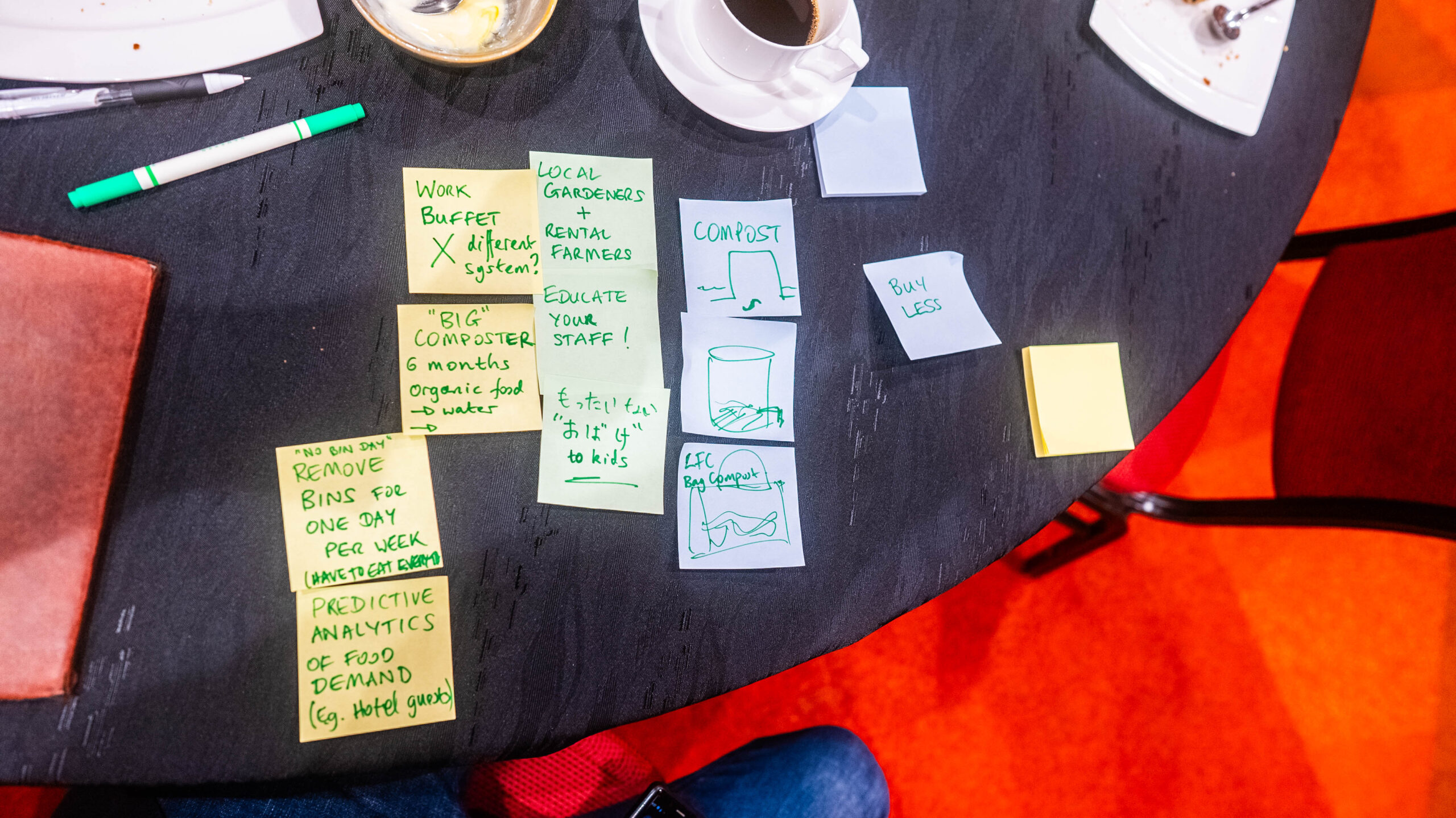Member? Please login
Lifting the Lid on Food Waste

Written by Sterling Content
March 1, 2024
Past Event Round Ups
With a 2030 target to halve per capita global food waste at the retail and consumer levels and to reduce food loss along production and supply chains, Sustainable Goal 12 (Responsible Consumption and Production) calls on the world to change its relationship with food.
Globally, about one third of all food produced annually, equivalent to 1.3 billion tonnes, is wasted, despite 2 billion people being classified as hungry or malnourished, according to the UN Environment Programme. In Japan alone, 5.23 million tonnes of “still-edible food” was disposed of in fiscal 2021—half by businesses and half by households—according to a 2023 report by the Ministry of Agriculture, Forestry and Fisheries.
The loss and waste of food is not only an economic and social dilemma, but an environmental one, too, as energy is wasted throughout the value chain and rotting food produces methane, which contributes to climate change.
As food is a topic that affects everyone—both personally and in their workplaces or communities—the British Chamber of Commerce in Japan (BCCJ) invited members to consider food loss and food waste at an interactive event in February. Facilitated by Tove Kinooka, a member of the BCCJ’s Responsible Business Taskforce, the breakfast session was designed to facilitate learning, uncover best practice examples and discuss solutions for households, workplaces and communities.
Understanding systems
Hideki Obata, executive managing officer of Norinchukin Research Institute, began his presentation by outlining the impact of consumer behaviour related to ehomaki, a rolled sushi enjoyed on Setsubun, a national holiday held in Japan in February. As the food is traditionally eaten only on the day itself, vast numbers of ehomaki remain unsold and are thrown away annually.
In 2018, Japan’s Ministry of Agriculture, Forestry and Fisheries asked retailers not to produce excessive amounts of ehomaki, which prompted retailers to place fewer on shelves and to ask customers to pre-order the sushi.
This is just one example of food waste, which occurs during the post-harvest passage through the supply chain, from production to distribution, Obata explained. Food loss, on the other hand, is a subcategory of food waste and refers to edible food that is discarded or lost along the journey from the stages of harvest, production, storage, processing and distribution.
In Japan, food waste totals about 24 million tonnes annually, of which more than 5 million tonnes is food loss. Food waste is most common during process and distribution, with business food waste (including tradable or inedible food) accounting for 16.7 million tonnes annually. Of that, 2.97 million tonnes is business food loss (including unsold, non-standard, returned and leftover food).
By process, most of Japan’s food waste occurs during processing (13.86 million tonnes), followed by food service (1.48 million tonnes), retail (1.14 million tonnes) and wholesale (0.22 million tonnes). In contrast, household food waste amounts to 7.32 million tonnes, of which 2.44 million tonnes is food loss.
Obata said society should move towards a better circular economy, focusing on reduction and recycling, describing the reduction of food loss as a moral imperative as more food is disposed of globally than is provided by the World Food Programme for people living in hunger.
He pointed out examples of companies using technology to create more sustainable systems. Japan Food Ecology Center, Inc. manufactures liquid fermented feed for pigs from food loss and food waste from food processors and retailers. Meanwhile, at Astra Food Plan Co., Ltd., a machine applies superheated steam to scraps and peels of fruit and vegetables, converting them into easier-to-handle, nutrient-preserved dry powders. Decay inhibition is another method to reduce food waste. While antiseptic coating was once used on fruit, Agro Fresh has created an alternative plant-based edible coating that extends fruits’ shelf life by 2–4 days, resulting in 50% less food waste.
Changing mindsets
Markus Kosch, general manager of Hilton Tokyo Bay, introduced why reducing food waste is part of Hilton’s global commitment to drive responsible travel. The company’s environmental, social and governance strategy, Travel with Purpose, aims to create positive impact across its operations, supply chain and communities.
One way Hilton is addressing food waste, which it aims to cut by half of its 2008 baseline by 2030, is through working with Winnow. The UK-based company’s AI-enabled tool, Winnow Vision, takes photos of wasted food as it’s thrown away and, using the images, trains itself to recognise what has been put in the bin and records the data. Managers can then access Winnow’s reports, even on a daily basis, to analyse their food waste and better understand how to reduce it.
Winnow is being utilised at 13 Hilton hotels in Japan, including Hilton Tokyo Bay, as well as several in the Asia Pacific region.
Reflecting on the introduction of the technology at Hilton Tokyo Bay, Kosch said it “took discipline” as all kitchen waste had to go into the one bin, but noted that the system now acts “like a policeman in the kitchen,” encouraging changes in culture and behaviour.
For example, Hilton Tokyo Bay once had three mise en place setup stations and three breakfast teams (one of each of its restaurants), but Winnow’s data demonstrated it could operate efficiently with one mise en place and one breakfast team, thereby reducing a lot of waste, he said.
Indeed, since installing Winnow in January 2020, the hotel has saved 150 tonnes of food, equating to 665 tonnes of CO2. Costs are also down by 90%.
Practical tips
The final presentation was by Darren Prest, founder and director of Harbour View Services, the food service provider for Yokohama International School, which has 900 students and faculty. He outlined the strategies he and his team use to reduce food waste.
Every Monday, the team sources fresh seasonal produce using local markets and organic farms to help ensure the items last longer. Once food arrives, every box is emptied so that any ripe produce does not damage its neighbours. If items need to be frozen—such as ripe bananas that can be peeled and kept for banana cake—they are made flat and air is removed so they can be defrosted more quickly later, thereby reducing the likelihood of damage or waste.
Throughout the week, Prest serves smaller portions to help children finish their lunches and encourages those who want more to come back for a second portion. Soup is listed as the “soup of the day” to allow less-fresh vegetables or other items to be used, rather than thrown away. Similarly, every Friday the menu is pizza and chahan (Japanese fried rice) made using produce that would not be edible in the following week. Any vegetable peelings or other scraps are kept at the bottom of the freezer and turned into stock weekly.
If hot food, such as bolognese can be reused in dishes such as taco rice or chilli, it is chilled to 10˚C within two hours—such as by putting it in dishes with greater surface area or on top of ice—and placed in the fridge or freezer. For reheating, items are brought from fridge temperature to 80˚C, making a thermometer an essential tool for reducing food loss and waste, he said. Other important items include a marker pen or stickers for noting when packages are opened and a sharp knife as cutting produce with a blunt knife bruises them, reducing their shelf life.
Co-created solutions
Attendees spent time in groups considering how to reduce food waste at home, at work and in community settings. Here are their ideas:
- Food preparation and consumption
• More meal planning
• Weekly reviews of what is in the fridge and freezer
• Do food shopping more regularly and buy only what is needed
• Change mindsets on “ugly produce”
• Pick from the front row at the supermarket as these items are nearer their expiry date
• Rotate items in your own fridge so no produce is forgotten
• Eat leftovers for breakfast
• Ask eateries for a doggy bag
• Use a blender to create drinks or food from ingredients not at their best
• Buy products from identifiable sources, such as products with the farm’s name
• Dine out less
• Choose less buffet-style meals, more plated meals
• Eateries could limit the number of dishes they serve daily and then close when they serve everything
• Make compost from food waste; install a compost bin in the office
• “Every ingredient can have a second life” – for example, chicken bones left over from a roast dinner can be used for stock
- Awareness and education
• Learn more about food production to increase appreciation of food
• Grow produce, such as in a garden, rooftop or community space
• Raise awareness of food production by working with local farmers
• Educate about the importance of combating food waste
• Use predictive analytics of food demand
• Introduce campaigns at work such as “No Bin Day” so everyone has to eat everything on their plate











